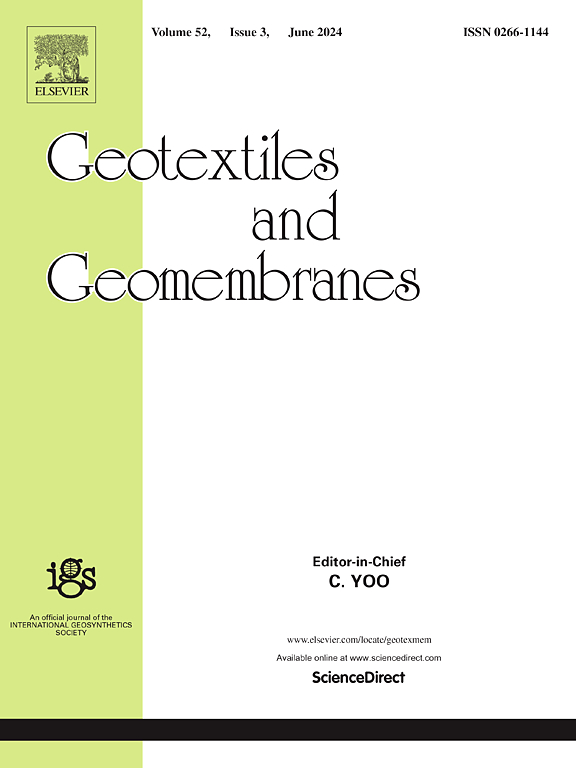Model tests on wicking geosynthetic composite reinforced bases over weak subgrade
IF 6.2
1区 工程技术
Q1 ENGINEERING, GEOLOGICAL
引用次数: 0
Abstract
Road performance is significantly enhanced by incorporating geosynthetics through their reinforcement and drainage functions. This study introduces a novel geosynthetic that integrates these functions. It is made of biaxial polypropylene geogrids heat-bonded to wicking nonwoven geotextiles (WNWGs). WNWGs are chemically treated to be hydrophilic and thus possess rapid wetting and wicking properties while preserving the large lateral drainage functionality of conventional nonwoven geotextiles. To assess the combined reinforcement and drainage performance of this material, a series of model tests including rainfall simulation and plate loading tests were performed on the WNWG-geogrid composite reinforced bases over weak subgrade using a customized model test apparatus. The results confirmed that the inclusion of wicking geosynthetic composite significantly enhanced drainage, stiffness, and bearing capacity of road bases compared to the conventional nonwoven geotextile-geogrid reinforcement and the unreinforced condition. The modulus improvement factor (MIF) for this wicking composite was 2.74 as compared to 1.46 for the conventional nonwoven geotextile-geogrid reinforcement. The findings from this study demonstrate the promising performance of this new composite and provide a valuable reference for full-scale tests and applications on roads.
软弱地基上吸湿土工合成复合材料加筋地基模型试验
土工合成材料的加固和排水功能大大提高了道路性能。本研究介绍了一种集成了这些功能的新型土工合成材料。它是由双轴聚丙烯土工格栅热粘合到吸芯非织造土工布(WNWGs)。WNWGs经过化学处理,具有亲水性,因此具有快速润湿和排芯性能,同时保留了传统非织造土工布的大侧向排水功能。为了评估该材料的综合配筋和排水性能,使用定制的模型试验装置对弱路基上的wnwg -土工格栅复合地基进行了降雨模拟和板载试验等一系列模型试验。结果证实,与常规非织造土工布-土工格栅加固和未加筋条件相比,加入吸芯土工合成复合材料显著提高了道路基层的排水能力、刚度和承载能力。这种吸芯复合材料的模量改善系数(MIF)为2.74,而传统的非织造土工布-土工格栅增强材料的模量改善系数为1.46。研究结果证明了这种新型复合材料的良好性能,并为全面测试和道路应用提供了有价值的参考。
本文章由计算机程序翻译,如有差异,请以英文原文为准。
求助全文
约1分钟内获得全文
求助全文
来源期刊

Geotextiles and Geomembranes
地学-地球科学综合
CiteScore
9.50
自引率
21.20%
发文量
111
审稿时长
59 days
期刊介绍:
The range of products and their applications has expanded rapidly over the last decade with geotextiles and geomembranes being specified world wide. This rapid growth is paralleled by a virtual explosion of technology. Current reference books and even manufacturers' sponsored publications tend to date very quickly and the need for a vehicle to bring together and discuss the growing body of technology now available has become evident.
Geotextiles and Geomembranes fills this need and provides a forum for the dissemination of information amongst research workers, designers, users and manufacturers. By providing a growing fund of information the journal increases general awareness, prompts further research and assists in the establishment of international codes and regulations.
 求助内容:
求助内容: 应助结果提醒方式:
应助结果提醒方式:


